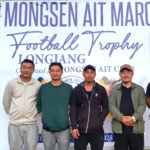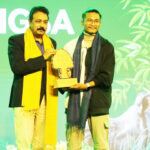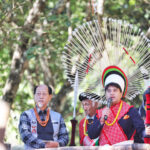Did you know that the Sumi Naga name for Orion’s Belt is “Phoghwosülesipfemi”?
The Highland Institute, Kohima, is currently hosting a unique exhibition titled Look Up, which delves into the rich heritage of indigenous astronomy, biodiversity, and cultural practices of the Naga tribes. Originally scheduled to run from September 21 to October 5, 2024, the exhibition has been extended for another week due to popular demand.
One of the exhibition’s standout features is the Naga interpretation of constellations, where fascinating stories reveal a deep connection between Naga politics and the stars. According to anthropologist Jelle Wouters, for centuries, raids were central to Naga politics, with raids carried out for revenge, wealth, fame, and protection. These took place both between rival Naga clans and against expansionist valley kingdoms. Some of those who fell during these raids were remembered by the Naga people as stars.
Anthropologist Habs Eberhard Kauffman’s records show that the Sumi Naga name for Orion’s Belt is “Phoghwosülesipfemi,” symbolizing three men killed in an ambush who later transformed into stars. Similarly, the Angami Naga refer to the Pleiades as “Zuthekroko,” or ‘Rat diggers,’ named after men ambushed while hunting bamboo rats.

In Ao Naga tradition, Keyi Achi refers to an eclipse, often described as a tiger devouring the sun or moon. During an eclipse, the Ao believed that a celestial tiger was attacking the sun (solar eclipse) or the moon (lunar eclipse). To ward off the tiger and restore light, villagers would rush to the log drum and beat it loudly, using the same drumming patterns employed to scare off real tigers. This cosmological view reflects how deeply the Ao tied their earthly dangers to celestial events.
This tradition is preserved in Ao oral history, passed down through ancestors like Idizungba, Scvbong-Lvmba, and Kilep Alvm, who contributed to a missionary dictionary, documented in an archive by Connie Shakespeare.
The exhibition also highlights the intricate relationship between Nagaland’s biodiversity and its cultural fabric. Orchids, for example, played a significant role in traditional attire and rituals across different Naga tribes. Robin Wall Kimmerer’s Braiding Sweetgrass documents how the Lotha tribe used yellow orchid stalks to create intricate headgear patterns. The Aos fashioned leggings from orchid skins, while the Angamis adorned ceremonial spears with orchids, which served as symbols of status and power.

A section of the exhibition delves into myths surrounding gibbons, which play a significant role in the folklore of several Naga tribes. Among the Lotha Nagas, it was believed that women could transform into gibbons by applying a special white rice beer paste to their foreheads, a myth that reflected the gibbon’s mysterious, human-like nature.

The Lotha men, on the other hand, wore thongko, wigs made from the fur of male gibbons’ arms, especially in ceremonial or wartime situations. This practice underscored the belief in a mystical connection between humans and gibbons, granting these animals an almost sacred status.
For the Rengma Nagas, gibbons were viewed as protectors of the land. Several villages refrained from killing gibbons, believing they would drive away other monkeys that threatened the crops. This reverence reflected the Rengma’s respect for these creatures, which they saw as contributing to the village’s sustenance rather than being pests.
However, dreaming of a gibbon was considered a bad omen. Since gibbons were believed to never drink water from birth until death, such a dream symbolized a life of poverty and hardship, as water was a symbol of wealth and prosperity.
Among the Ao Nagas, gibbons played a unique role in ceremonies related to pestilence. During serious epidemics, the village would perform a ritual known as Waraleptang (pestilence killing), where a live gibbon—remarkably tame in Ao territory—was sacrificed. The priest would chant prayers asking the illness to depart with the gibbon’s spirit, and the animal’s body was placed along the village path as a symbol of protection.
The exhibition doesn’t just focus on myths and traditions but also emphasizes the modern importance of conserving Nagaland’s biodiversity. Insights from local conservationists are woven into the display, encouraging reflection on how traditional knowledge can continue to inform today’s environmental efforts. Nagaland’s “Butterfly Man,” Tsehetsholo Naro, highlighted that while the state is home to 202 species of butterflies, 34 are on the verge of extinction. The exhibition aims to raise awareness about the importance of butterfly conservation and educate younger generations about the crucial role butterflies play in the ecosystem.

Akumtong, the coordinator of the exhibition, explained to MT that much of the information on display was gathered through archival research and interviews with local experts and also a lot of help from Pitts Museum. “We hope to inspire a renewed appreciation for our heritage and the environment. Our connection with nature is not just historical but continues to guide us today,” he said.
The Look Up exhibition provides a rare opportunity to explore the spiritual and cultural connections the Naga people have maintained with the skies and the natural world. Through a combination of archival material, oral traditions, and interactive exhibits, visitors are invited to rediscover the profound wisdom of Nagaland’s ancestors and its biodiversity—knowledge that continues to inspire conservation efforts today.



